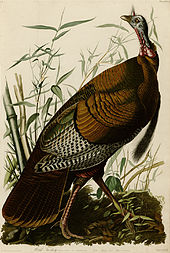We know John James Audubon from his classic collection of prints of North American birds in the book, The Birds of America. Young Audubon made a living as a partner in a general store and also by hunting and selling animal skins. He was finally led to pursue two life long passions: birds and painting. It is reported that every bird Audubon painted, he shot . But this paradox was not lost on him. "The moment a bird was dead," he said, "no matter how beautiful it had been in life, the pleasure of possession became blunted for me."
Young John James Audubon. Portrait by john Syme, 1826
Audubon's study was a serious one. He is credited with being the first to band a bird to study its habits. By tying a colored yarn to the leg of an Eastern Phoebe he learned that the bird returned to the same nesting site year after year.
His goal was to paint every bird in America that he could. His travels took him to the Florida Keys, the east coast and mid west of the young nation that was his adopted home. He took his paintings to Europe where he sold subscriptions to finance the printing of his works into large, expensive books that were purchased by wealthy patrons, eager to view the best images of North American birds.

Plate 1 of The Birds of America by Audubon, depicting a Wild Turkey
Ill health plagued Audubon much of his life and finally brought him to a depleted condition and eventual death in 1851. He is buried in Manhattan, New York City, New York. His fame has resulted in numerous parks and schools being named after him, as well as the well known Audubon Society.
Audubon in later years. Portrait by George P. A. Healy; Museum of Science, Boston
Joyeux Anniversaire, Jean-Jacques!
Locally, we are always reminded of this icon natural history when we see the familiar and abundant Audubon's Yellow-Rumped Warbler. Be on the look out for these friendly birds as they return to breed and raise their young in beautiful Northeast Washington!

Audubon's Yellow-rumped Warbler (male), photo courtesy of the Macaulay Library, Cornell Lab of Ornithology
Good Birding!
- Hawkeye















